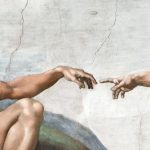 A few years ago, I walked with a line of tourists through Vatican City, down hallways hung with old masters, into the Sistine Chapel, where on the ceiling is depicted the creation of Adam – according to some, one of the most significant artistic accomplishments of humanity – representing the gift of life, the birth of the human race.
A few years ago, I walked with a line of tourists through Vatican City, down hallways hung with old masters, into the Sistine Chapel, where on the ceiling is depicted the creation of Adam – according to some, one of the most significant artistic accomplishments of humanity – representing the gift of life, the birth of the human race.
Art, music and architecture have long been an inspiration, a path up from the mud and toil of ordinary life, inviting mankind to a higher plane of existence, to an exaltation of the spirit. The soaring cathedrals, temples, music and religious art of the past served to remind mankind of higher harmonics of life, of his essentially spiritual nature. And in art as in life, there are many ways that spiritual nature can be expressed – from the otherworldly domes of the Sheikh Zayed mosque, the Great Synagogue of Budapest, to the graceful simplicity of a Shaker meeting house, or a garden of flowers.
Perhaps artistic expression allows man to share the joy of the Creator in fashioning a universe. “The greatest joy there is in life,” said Scientology founder L. Ron Hubbard, “is creating.”
But creative expression can be difficult, and so drugs have become a sort of shortcut.
Back in the 1960s, my English professor used Coleridge’s poem “Kubla Khan” as an illustration of how drugs could supposedly enhance creativity. The first part, said the professor – written from an opium-induced dream – is vivid and powerful. The second part – flat and uninspired – was written straight.
The professor’s implication for his class of budding writers: If you want to be creative, use drugs.
Such advice is not just a figment of the 1960s, as drugs have been a parasite on creative activity for centuries, and a death sentence to many of the most creative individuals. And the theme that drugs enhance creativity has continued unabated into today’s re-introduction of LSD and other psychedelic substances.
Meanwhile the body count of creative geniuses continues to climb. The death toll includes Jim Morrison, Janice Joplin, Michael Jackson, Prince, Jimi Hendrix, Chris Farley, John Belushi, and thousands of other brilliant men and women in search of a creative edge. Promised altered reality, they chased an elusive high with ever-increasing dosages enslaved by the pain of withdrawal.
But what’s the actual mechanism, and why are drugs often linked to creativity? “Drugs (LSD, marijuana, alcohol, whatever) produce a threat to the body like any other poison,” said L. Ron Hubbard in an essay on 8 Jan. 1969. And when the body is threatened, the being himself feels threatened with oblivion and so begins to obsessively create. What he creates are hallucinations. His reality is then filled with things not actually there, but a composite of his surroundings plus imagination plus things from his past. “Such persons as drug takers and the insane,” said Hubbard, “are thus slightly or wholly on an apparently different time track of … events.”
Creative people go out of agreement with everyday reality, and that vision of new possibilities is why we cherish and generously reward those who create the future. But drugs merely fill the body with poison, to squeeze a bag of nightmares, and what comes out is seldom creative or illuminating, and the results are often addiction and death for the writer, artist, painter, architect, or musician who experiments with drugs. And so the promise of the spirit, engendered in the aesthetics of art, often ends up – through drugs – mired in degradation, addiction and insanity.
Creativity has long been a sort of magical realm, a connection with the Muses, those daughters of Zeus who inspired mere mortals to wonderful creations. But drugs deny the spirit, fill the body with poison to try and squeeze out a few new ideas or a song lyric. As such, drugs are the antithesis of a life of the spirit and often spell the end of a promising and creative career.

